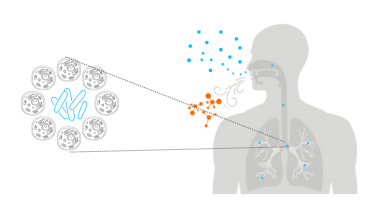Infectious diseases are responsible for a huge global burden of disease that impacts public health systems and economies worldwide, especially affecting vulnerable populations.
Exhaled breath contains volatile organic compounds (VOCs) that have originated from many metabolic processes throughout the body. Research has indicated that VOCs present in breath are associated with infectious diseases, and therefore show promise as non-invasive biomarkers. Pathogenic microbes can alter the VOCs in breath either through altered metabolic pathways due to the host immune response, or with certain pathogens like bacteria and fungi, their own endogenous metabolic processes. VOCs originating from infection sites all over the body can be exchanged from the bloodstream into the air in the lungs at the alveolar membrane and exhaled in breath.
Some infectious diseases predominantly affect the lungs and other tissues in the respiratory tract such as the nose and throat. As breath is in direct contact with these tissues, analysis of breath can provide a better insight into local respiratory diseases as opposed to blood or urine which are more indirect. Exhaled breath offers a unique roster of potential biomarkers arising from an infection and can be collected completely non-invasively for infectious disease testing.
FURTHER READING
Other recommended reading:

- DOCUMENT: Quick Start Guide – Incorporating Breath Analysis into Infectious Disease Research
- NEWS: Owlstone Medical secures $6.5 million to support development of breath-based diagnostics for infectious disease.
- PAPER: Detection of Clostridioides difficile infection by assessment of exhaled breath volatile organic compounds.
- CASE STUDY: Breath VOC biomarkers for infectious diseases.
- POSTER: Identifying and characterizing VOCs in exhaled breath from SARS-CoV-2 positive individuals.
Download the Breath Biopsy Guide to learn about breath biomarkers and their applications






